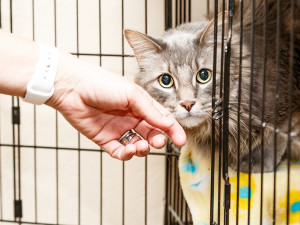One Is the Loneliest Number: What to Know About ‘Single Kitten Syndrome’
Why adopting two kittens may be easier (and better for them) than adopting one

Share Article
You’ve heard the saying: all things in moderation. Well, there are exceptions to every rule. In this case, the exception is kittens. You can never have too many of those. In fact, experts agree that two kittens are better than one – and even three is within the bounds of reason.
That’s right; it’s better to adopt a couple of kittens rather than an individual kitten. Caring for a pair of kittens can be less work in many ways than having a single kitten and far better for the felines involved. And that third kitten will not add much to the workload, so again, no issue with moderation there. It’s hard, if not impossible, to overload on kittens.

littleKin™ is Kinship’s home just for puppy and kitten parents. Bop over to check out expert advice, new pet tools, and special deals—all curated for your newest family member.
opens in a new tabAnimal rescue centres and shelters often even encourage future parents to adopt kittens in pairs. They don’t have to be littermates, but being close in age is important. In cases where three kittens are available, it’s becoming increasingly common to place all three together in a home rather than to place two together and the third on its own. (If adopting a single cat is important to someone, many organisations will steer them to adopting an adult cat instead of a kitten.)
What is ‘single kitten syndrome’?
These adopt-in-pairs policies are not just about placing more cats in loving homes, despite that being a favourable side effect. Adopting a lone kitten can lead to what is commonly referred to as ‘single kitten syndrome’; a solo kitten is less likely to grow up as well-adjusted and happy as cats who grew up with another kitten.
Kittens who are raised as only cats have an increased chance of developing various behavioural problems later in life. This includes biting people as they walk away, avoiding the litter box and destructive behaviour like scratching furnitureopens in a new tab. There is a tendency for single kittens to be excessively dependent on people and seek to be in their company constantly, which may account for the constant meowingopens in a new tab and sucking on clothes so common in cats that were single kittens.
In contrast, being raised with another kitten offers a multitude of advantages to the cats, and each one offers benefits to the human members of the household as well. Kittens keep each other occupied, which keeps them out of trouble. The physical and mental exercise, socialising, comfort of being together and fun of endless playtime provide enrichment to both cats.
The opportunities to engage in natural behaviours lead to less undesirable behaviour; they are not as likely to relentlessly demand attention from people or to become agents of destruction. Kittens adjust to a new home better when they join it with a familiar friend and a smoother transition with less stress is good for everybody.
Benefits of adopting two kittens
Kittens learn from interactions with their peers and some of those lessons are hard to learn from people – at least not as effectively. Learning to be gentle with their teeth (bite inhibition) and their claws (let’s call it scratch inhibition) is a lesson best taught by another kitten.
When they claw at one another or use their teeth on each other, they learn boundaries about how hard to use these weapons in social interactions. It’s far more pleasant to have the kittens learn these skills from each other rather than from biting and scratching the humans in the household.
Adopting a pair often makes it easier to integrate the new kittens into a household with an adult cat. It may seem counterintuitive, but many adult cats have an easier time when two kittens join the family, compared to when just one cat joins. The biggest plus? They occupy each other without relentlessly bothering the older cat.
If a family wants two cats eventually anyway, adopting a pair of kittens is generally a smoother path than adopting one cat now and another one later. It’s easier to have two kittens as playmates than it is to add an adult cat later; adult cats don’t always respond well to new members joining the family.
Everyone knows that two heads are better than one. To prevent the issues associated with ‘single kitten syndrome’ requires not just two heads, two tails or two faces, but (oh the joy of it) two entire kittens.

Karen B. London, PhD, CAAB, CPDT-KA
Karen B. London, Ph.D., is a Certified Applied Animal Behaviorist and Certified Professional Dog Trainer who specializes in working with dogs with serious behavioral issues, including aggression, and has also trained other animals including cats, birds, snakes, and insects. She writes the animal column for the Arizona Daily Sun and is an Adjunct Professor in the Department of Biological Sciences at Northern Arizona University. She is the author of six books about training and behavior, including her most recent, Treat Everyone Like a Dog: How a Dog Trainer’s World View Can Improve Your Lifeopens in a new tab.
Related articles
![White cat switching on lamp on couch]() opens in a new tab
opens in a new tabWhy Does Your Cat Wake You Up at Night?
You want to sleep, your cat wants to party. Here’s how to deal with it
![Kitten scratching fabric sofa]() opens in a new tab
opens in a new tabHow to Stop Your Cat From Absolutely Ripping Apart Your Couch
Placing a cat tree or post in a room only, uh, scratches the surface of solving this problem
- opens in a new tab
Cat Allergies: Do Hypoallergenic Cats Exist?
If the sniffles are getting you down, don’t stress: you have options





